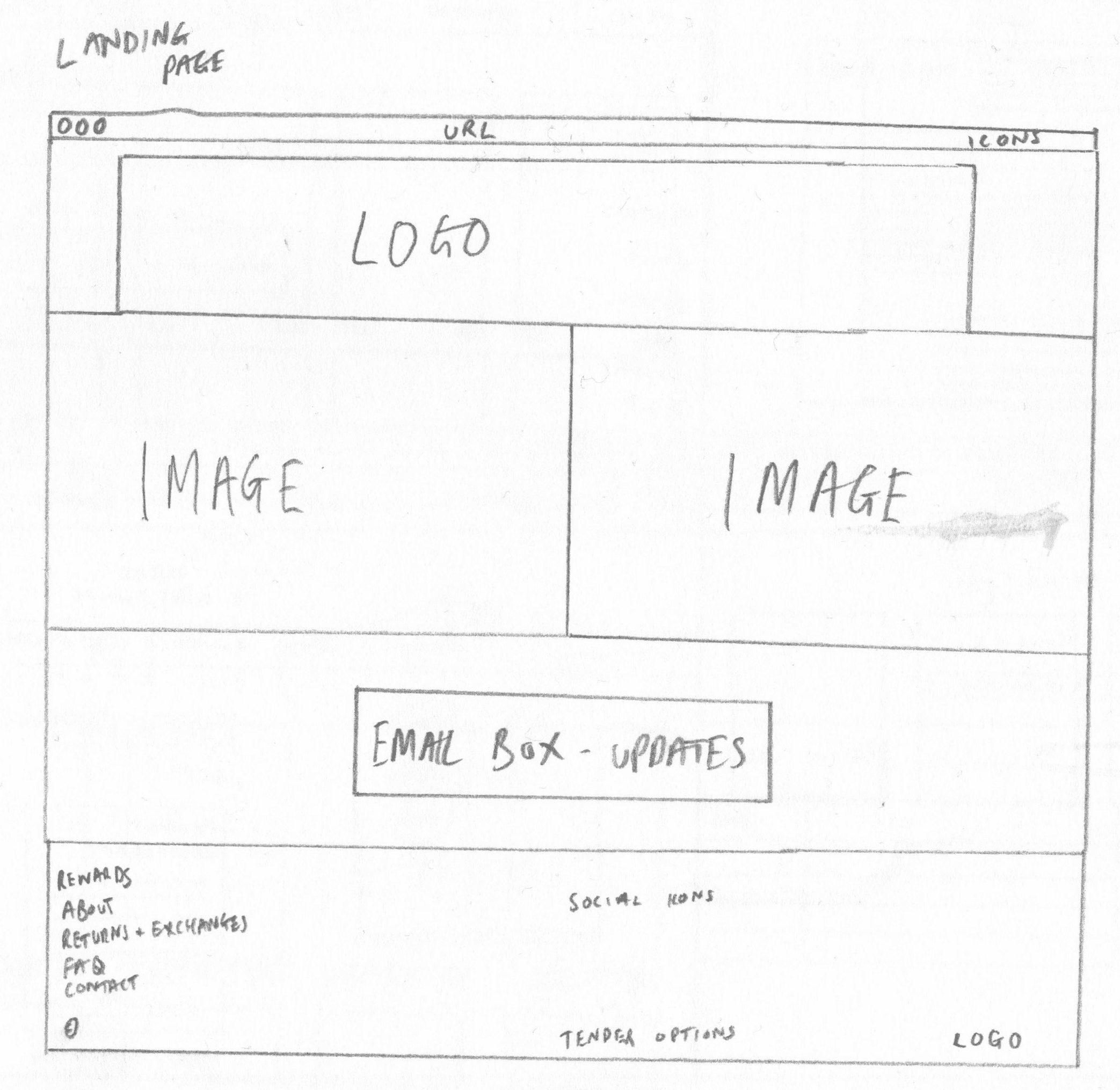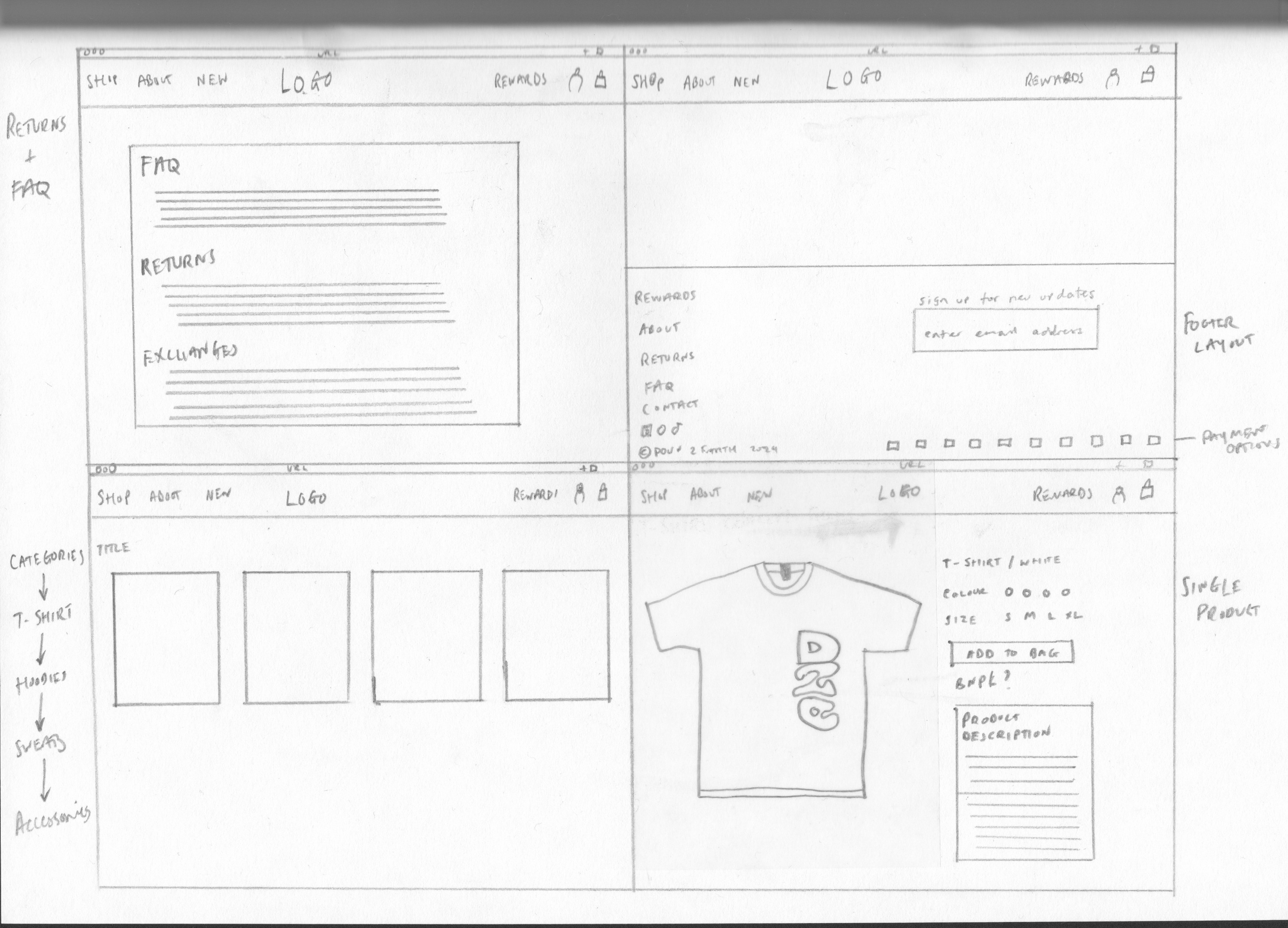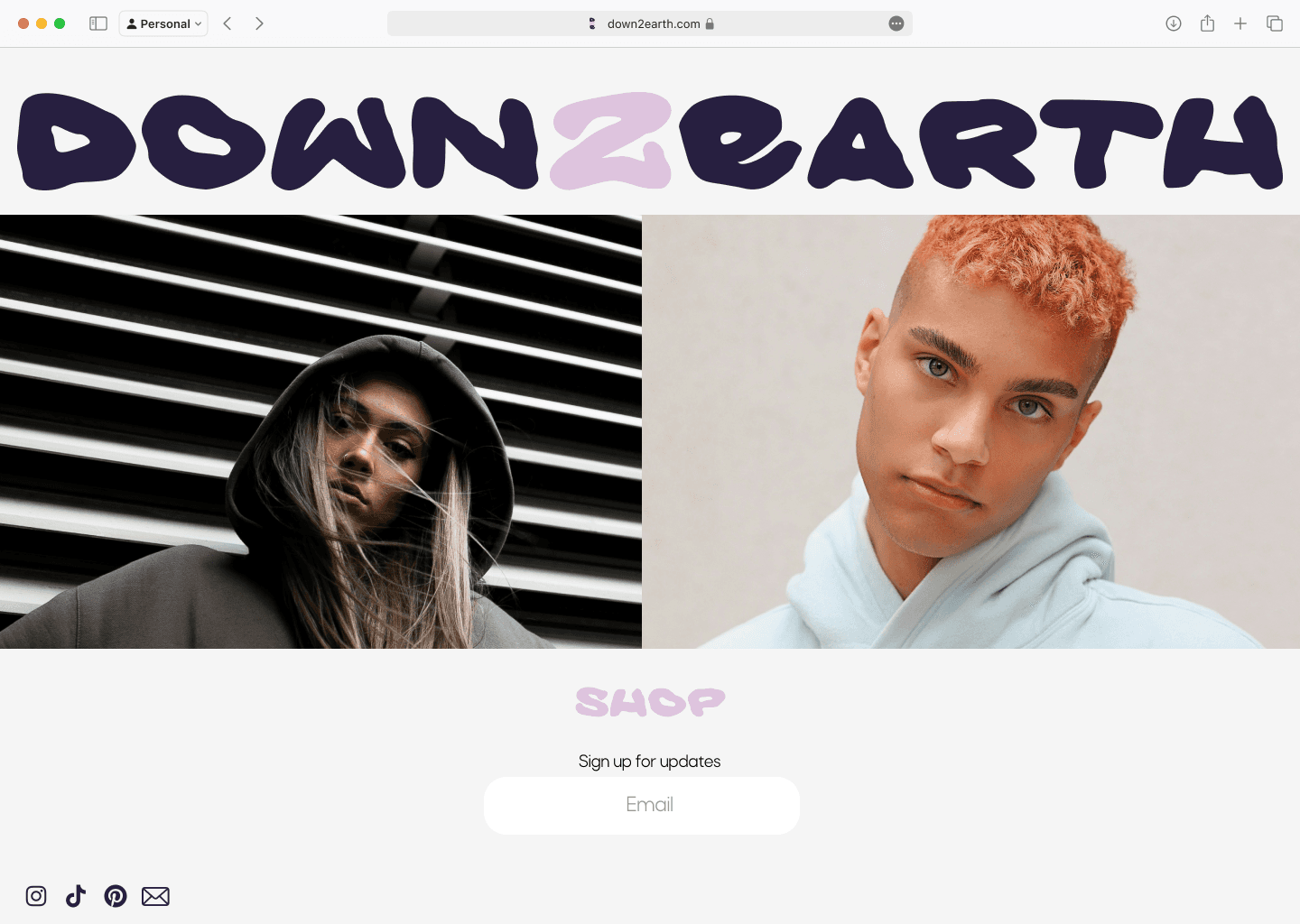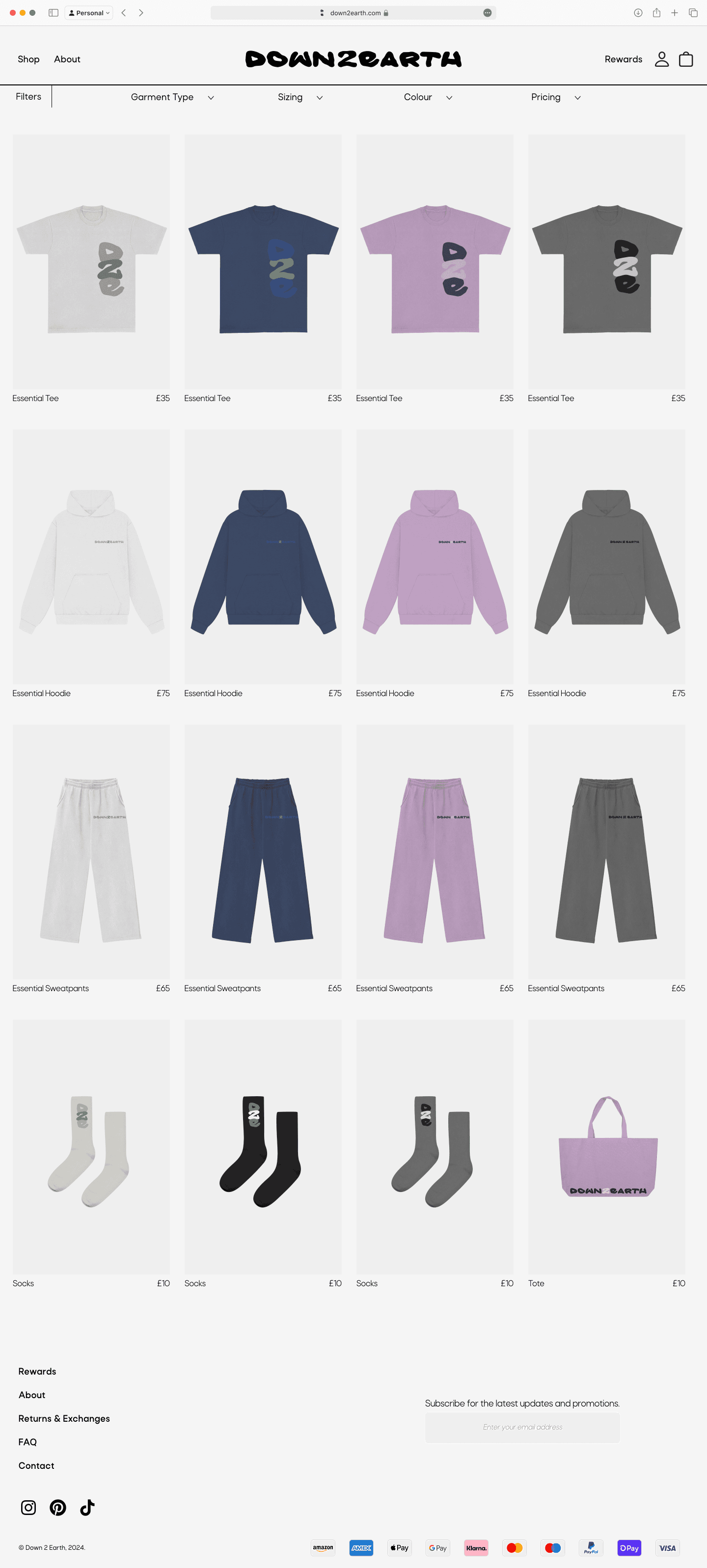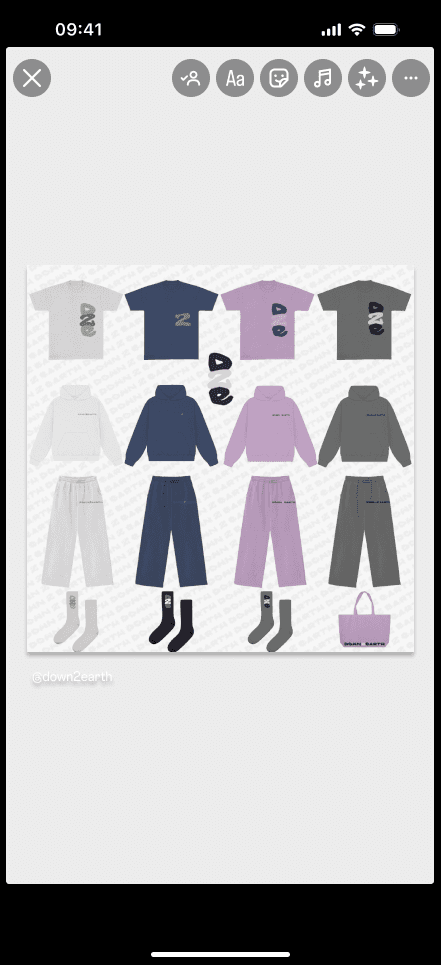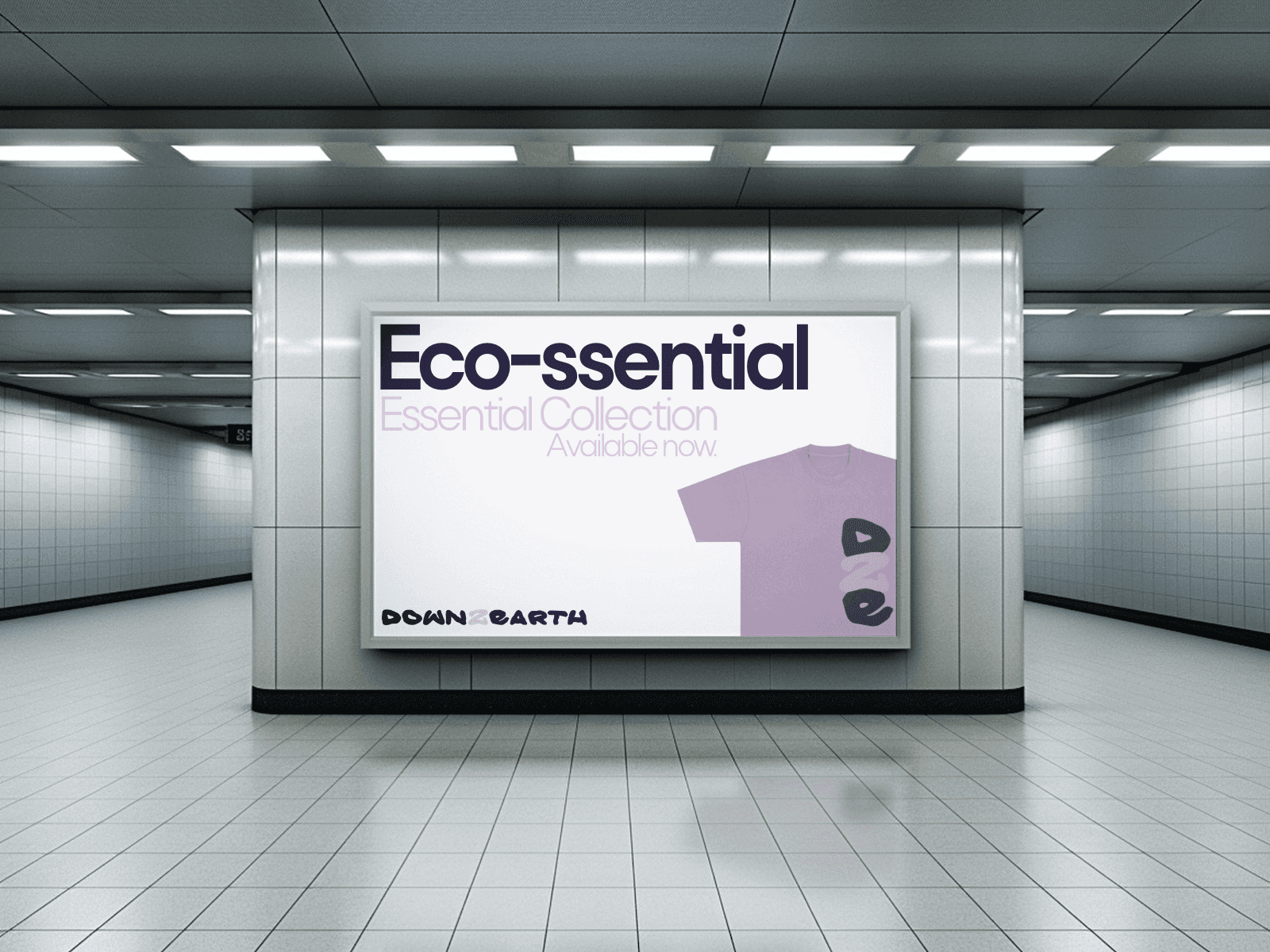DM7908 Digital Media Practice | Major Project Portfolio and Reflective Practice
Monday, October 14, 2024
Introduction
The aim for the Final Major Project was to design specific deliverables for a clothing brand called 'Down 2 Earth' (referred to at times as D2E). Within this brief the objectives were to design all brand assets, an intuitive and innovative website prototype, an Instagram account and a marketing campaign that challenged the status quo of the fashion industry's impact on the climate and ethical considerations around fast-fashion using specific marketing techniques to engage consumers and draw awareness to the brand’s vision.
Significant amounts of research was undertaken to provide justified design decisions and these are laid out through the research, design practice and reflective sections of the project. This project is a amalgamation of all the design education over the last two years of the MA and culminates in a final piece that should reflect industry level work that will secure future employment into a design studio or via freelance activities alongside full-time work.
This area was chosen because the fashion industry has a lot of opportunities for improvement in relation to its sustainability and the ethical conditions and practices it currently possesses. The research unpicks the failures in detail but it is worth noting that 'the production of clothing consumes vast amounts of resources, generating significant waste and contributes to pollution' with a start in disposable fashion beginning in the early twentieth-century (Mohammed, 2024; Jin, 2024).
Project Objectives
The project’s objectives are:
• Design a digital marketplace through the means of a website prototype using design software Figma.
• Create a Instagram account that promotes the brand’s vision and raises awareness about climate issues through educating followers on the brand’s vision and purpose.
Design Research
The project’s research was conducted through primary and secondary methods. The primary research came from survey distribution via social media platforms like Instagram. Instagram was selected during the research proposal phase as it was determined that this platform is used significantly by the target audience which resulted in guaranteed responses. It is also the dominant platform for clothing brands to promote their products (Keenan, 2024). The survey was brief and featured questions that understood the thoughts and feelings of the Gen-Z/Millennial demographic purchasing fashion in 2024. This was essential for understanding how to design the deliverables for this project.
The data collected from participants sought to understand age, annual income, and social media usage paired with their agreements on positioning statements about purchasing habits. The survey captured fifty-seven responses which was over the sample size goal stated in the research proposal. There was a 55-45% split for female to male respondents whilst only 25% of the sample were high-income earners (above £40,000) allowing for a more economically diverse group of participants. 70% of respondents reported that sustainability affects their purchasing choices with 60% of all the sample indicating they avoid products from unethical brands, showing a clear preference for ethical consumption. It is worth noting that the sustainable-conscious consumers tended to fall in the higher education and income brackets which reflects a more informed customer base.
The secondary research came from market and competitor analysis and academic resources on various sub-topics. It was also important to understand fashion industry trends, sustainability consciousness, and case studies of competitor brands to give a wider perspective on where Down 2 Earth would sit within the market landscape. Moreover, the research investigates digital analytics of social media accounts and the engagement with their followers to uncover the success and opportunities for the brand.
Starting with the primary research, it could have been simpler to break down the survey results between genders. Whilst this cross-examination is still appropriate, the project needed to conduct more advanced similarities and differences to further inform the design choices later on. This involved looking at the correlation between social media usage and sustainable purchasing habits. Key insights from the data include:
• Moderate social media users dominate the dataset, with most using social media for 1-3 hours per day. This suggests ample opportunities for brand engagement through well-targeted, time-efficient campaigns. The respondents who spent the most time on social media, however, are slightly less likely to base their purchases on sustainability. Albeit, they do avoid unethical products.
• Fashion engagement is relatively low compared to overall social media usage, which implies that fashion brands may need more interactive or immersive content to increase engagement levels.
• Sustainability-conscious behaviour is prominent, with a significant portion of respondents willing to change their purchasing decisions based on ethical considerations. This indicates that brands with strong sustainability credentials may have a competitive advantage.
• Adding income into the formula does not swing it considerably in one direction. There is only a slight positive correlation between purchasing choices and high levels of income.
With this data, the next step was to compare and contrast competitors in the industry and what could be gained from their business achievements. The two brands chosen are Broken Planet and Represent. Broken Planet distinguishes itself through its commitment to sustainability and innovation in fashion. By prioritising environmentally friendly practices and up-cycled materials, the brand appeals to a conscious consumer base. Their strategy of limited product releases, combined with transparent storytelling through their Instagram stories and posts, cultivates a community of loyal followers. On the other hand, Represent employs a branding approach that emphasises the fusion of heritage and modernity. By utilising high-grade materials and incorporating both timeless and avant-garde design elements, the brand curates an image of exclusivity and luxury. Through strategic collaborations with influencers and a robust social media presence, Represent effectively taps into a fashion-forward, digitally-native demographic.
These brands both have characteristics that D2E focuses on. D2E can emulate these strategies by first identifying its unique value proposition, whether it be through exclusive design, sustainable practices, or another distinguishing factor. Leveraging social media to tell a compelling brand story and engage directly with consumers can create a devoted community. Additionally, collaborations with influencers or other brands can amplify reach and lend credibility to a new brand. This approach, coupled with consistent, authentic engagement with the target audience, helps to build a strong community around the brand. By prioritising quality, narrative, and consumer engagement, D2E can successfully carve out its own space in the competitive fashion industry.
For this project, there were several sub-topics which were vital to research to gain a comprehensive overview of the fashion industry and sustainability.
Sustainable Clothing
The psychology of shopping is apt for another research project however 'our habits of consumption are intertwined with our identities, values, emotions and social influences' (Soron, 2010). Clothing becomes a visible statement to other human beings and portrays an identity within itself. The survey data indicated higher-educated and higher-earners more likely to purchase sustainably which suggests that brands must prioritise affordability without compromising on sustainability. This is backed by Anisah et al (2024) whose research details that Gen-Z is highly conscious of sustainability concerns but they often face challenges in choosing sustainable clothing over fast fashion due to price constraints and limited availability. In addition, Bläse et al deduct that the fear of missing out (known colloquially as FOMO) has a chokehold over consumers and directly 'influences…the purchase decision process' (2023).
Most of the survey respondents suggested that they interact with sustainable items and Parvin and Zilahy (2022) state that consumers who engage in activities such as garment care and recycling thereby extend the lifespan of clothing items. They also emphasise the need for further education on the environmental advantages of sustainable fashion to encourage more eco-friendly consumer behaviour. McNeil and Moore add that 'fashion consumers' attitudes' stem from 'their preconceptions toward sustainable fashion and…ethical consumption actions' (2015). Khare and Seshadri (2024) align with Parvin and Zilahy's view on garment care and detail that consumers can minimise their carbon footprint by adopting habits such as washing at a lower temperature, air drying and repairing garments instead of discarding them.
There are also environmental and social issues caused by mass production including pollution, labour exploitation and the depletion of natural resources (Jayakumari et al, 2024). Therefore, Down 2 Earth needs to promote limited releases to not over-manufacture and use ethical practices during production. Hur and Cassidy suggest that 'both the role of design and designers can be key to stimulating design practice' indicating us as designers have a big role to play in the future of the design production practice (2019).
Fast-Fashion and Ethical Practices
One of the project's deliverables is to create an Instagram account to promote the brand’s vision and to raise awareness about climate issues. Social media has had a negative impact on the environment by creating 'micro-trends' whereby fleeting, viral moments happen and exacerbate overconsumption and overproduction (Kothari and Sohoni, 2024). Fast fashion brand Shein is a monumental example of this with low-cost, high-speed production with consumers sharing their hauls on social media to followers leading to climate degradation and poor working conditions (Azevedo et al, 2024). Jin (n.d.) calls for both consumers and fashion brands to take responsibility for reducing waste and promoting ethical consumption. Brewer (2019) has a varied stance and argues that 'legal reforms and increased support' is what are needed 'to reorient the fashion industry'. Therefore, it is imperative to show up in this space and use social media for the opposite and educate consumers on better habits.
Bommanavar and Malipatil (2024) state that brands are integrating elements of slow fashion into their production models without completely abandoning the fast-fashion approach yet conclude that brands must fully commit to slow fashion principles rather than merely incorporating them superficially. Surjit et al (2024) concur and suggest that for corporate social responsibility to be truly effective, fast fashion brands must undergo a more profound transformation in their practices. This could be done with the role of technology shifting within the textile industry. Priyadarshini and Prasad (2024) detail that advancements in digital tools such as artificial intelligence (AI), large data models and blockchains are supporting brands in monitoring supply chains and waste and enhancing transparency.
Fashion Brand Websites
The main part of this design work is the website prototype as most of the desired consumer engagement would be through purchasing garments from the brand's online store. Fashion websites are a big piece of work as they have a vast amount of elements and coding for layout, user experience and interface to focus on how they influence user engagement and customer satisfaction (Feshchenko, 2024). Sultana et al's (2024) research discovers that to convert visitors into buyers the website must have clear product displays and fast loading times and have features that detail product descriptions, high-quality images and various payment options.
Consumer Behaviour in E-commerce
The e-commerce landscape is being shaped by Millennials and Z through their adoption of online shopping applications. Gen Z relies heavily on social media for product discovery whilst millennials prefer value and brand loyalty. (Widodo et al, 2024). Bernovskis et al (2024) argue that Society 5.0 (a human-centred approach to technology integration, where advanced technologies such as AI, the Internet of Things [IoT] and large data models are used to create personalised consumer experiences) is delivering exceptional customer service and present that businesses must adapt to this new paradigm to stay competitive.
Just over 10% of the survey respondents were students who would potentially sit within the Gen-Z bracket (unless they are mature students). Their income is sparser compared to the rest of the sample and therefore means that brands must provide competitive pricing to retain customer loyalty and drive sales (Mandagi and Lapian, 2024). This can be achieved through Buy Now, Pay Later (BNPL) methods which Gen-Z are particularly responsive to as they value convenience and are more likely to make spontaneous purchasing decisions (Sela and Saerang, 2024). These elements should be implemented on the website during the purchasing flow to support the target demographics conversion.
Fashion and The Role of Social Media
Social media provides an opportunity for fashion brands to visually tell a story through unique tools that can create engaging narratives (Nurgaliyeva, 2024). Ahmad et al (2015) note that social media platforms are a direct and dynamic communication channel between fashion brands and consumers. They discuss the role of fashion influencers who use their platforms to showcase trends and set new fashion standards. This could be essential for the sustainability piece to help drive forward the ethical commitments by holding companies accountable and letting consumers offer feedback (Kim and Kim, 2020). Users can share tips and recommendations through brand communities which links back to Jin's (2024) point on consumers taking some of the responsibility.
Social media enables fashion companies to showcase their products to a global audience without the need for traditional advertising which potentially can connect with more consumers than ever before and democratise the market (ApparelMagic, n.d.). Brands now have a closer relationship with their audience with real-time feedback during launches and is now a critical part of the fashion ecosystem allowing brands to stay connected to consumer needs.
E-Commerce and Social Media Engagement
Lastly, statistics provide current market data and provide the scale of the industry being designed for. The global fashion e-commerce market is expected to reach $1 trillion by the end of the year with social media being a crucial diver in direct interactions with brands and customers (Keenan, 2024). Globally, there are 2.71 billion active online shoppers which shows how vital it is to be with the size of the prize possible (Mileva, 2023). The large valuation refers back to the Society 5.0 integration earlier and the prediction that this will grow the market significantly in years to come (The Business Research Company, 2024).
Initial Concepts
A small amount of ideas were transitioned from the previous Branding Design and Strategy work completed in a past module. It was important to implement the feedback and improve the brand within this project. As stated in the research, high-quality images were necessary for sale conversion so the conceptualisation started by redesigning the clothing for the new website which would stand out strongly on the product pages. Previously, the clothing was an afterthought but as this is a fashion brand it was key to think deeper about the item that is being sold and how the site can built around that product.
Work begun on mind-mapping the brand from the beginning and really honing in on the research and what was imperative to action on. This gave good grounding and structure for design work to follow as it provided foundations to build from and reflection points to refer to during the process of the designs.
The website needed a structure for navigation so the wire framing process began using Figma. Figma is an design software that has become increasingly popular throughout the industry now for its simple UI and powerful tools. It is incredibly accessible as it can be browser-based and is free for education users. Starting it win Figma made designing much smoother as you are able to pivot between design and prototyping relatively simply and thus gave structure to building the model.
The wire frame was outlined through inspiration from market competitors sites to understand the navigation elements that have been successful for those fashion brands. After the base frame was there, sketches were drawn to provide a basis to design from in Figma.
The landing page or home page was the first to be drawn out. Placeholders were used to understand layout and later, images were cutout and stuck to work out placement of hero images and the footer was sketched. The footer needed to be simple, mainly for ease of user experience but also not to distract from a sophisticated main page layout. Looking at competitor sites, they are all very familiar, with links to FAQ's, contact pages and privacy policy information.
The sketches portray a simplistic UI because the ultimate aim was to scream luxury at website visitors. One of D2E's main selling points is its 'attainable luxury' element and that needed to be present in the design work. Having a complicated and clunky UI/UX would annoy customers and lead to them closing the window and shopping elsewhere to a site they are familiar with or trust because of those reasons.
There is a strong call to action through an email sign-up box for updates which draws attention to user engagement and retention strategies. Social media icons and footer links (Rewards, FAQ, Returns & Exchanges, Contact) make navigation easy and accessible, ensuring the essentials are immediately available. The layout for the about page focuses on delivering the brand’s mission, vision and values. The large logo and space for text allow the brand to communicate its values, such as sustainability and ethical production, directly to the user.
The initial concept stage reflects a strong focus on brand consistency and user experience. The garment designs directly influence the website’s visual identity, ensuring that the brand’s message - sustainability and luxury - is communicated through digital touch points. The sketches highlight a focus on ease of navigation, with clean designs allowing the products and brand story to stand out to browsers.
The attention to detail in planning, from product filters to rewards and engagement strategies, shows a considered approach to building a functional website. The consistency in the branding, from logos to the use of space and product imagery, ensures that the customer journey from discovering the brand to making a purchase is smooth, engaging, and aligned with the brand’s ethos.
Design Practice
The project provides a cohesive and deliberate design strategy for Down 2 Earth website. All of the design work was performed in Figma and took up a considerable amount of time for the project. Having the layout sketches meant the main elements could be built first and then placed onto every page they were required on. Figma uses 'Components' which allow you to design an element and then place it within a frame. More advantageous to this is when you update the main component, it updates across the whole file. Variants can be made from the components too which can allow you to switch between different versions of the same component. This was instrumental in the development of the website because of how the site needed to be consistent throughout the browsing experience.
The chosen palette is soft and earthy, with a mix of muted tones such as pastel purples, greys, whites, and greens. These colours reflect the brand’s commitment to sustainability, invoking a sense of calm and eco-friendliness. The subtle, natural tones used for both the garments and the website background create a harmonious look. This avoids visual clutter and aligns with the minimalist aesthetic that accompanies eco-conscious brands.
The typography used across the design process is consistent and distinct, with bold, organic-looking font 'Scary Club' which is used for the D2E logo. The letterforms have a raw, hand-drawn aesthetic, reinforcing the eco-conscious and natural ethos of the brand. This style gives an impression of authenticity and sustainability, aligning with the messaging of being climate-conscious.
The first version of the home page was similar to the one conceptualised in the research proposal but it felt inadequate using royalty-free images on the page of models that were not wearing real D2E garments. Therefore, the page was adapted to feature the clothing on the entry page. The clothing mockups were purchased online and edited using Pixelmator Pro. The mockups are used by fashion designers within the industry to help visualise ideas and then get them manufactured in factories. The clothing colour palette was chosen to match the colours of the branding assets within the brand bible and gave a visually appealing profile when customers browse.
The home page layout is polished, focusing heavily on visuals to capture the audience’s attention. Large hero images of the garments establish an emotional connection with the viewer, while the central placement of the logo creates a focal point for the brand.
The idea of the layout was to keep the user interface modern and engaging to relate to Feschenko's (2024) comments within their research findings. This resulted in a grid system that showcased small previews of the garments with product titles and pricing underneath which can be clicked to access full page views of each garment. The product layout is minimalist, showcasing items without distraction. The use of white space ensures that each product can be viewed clearly, and the filters at the top allow users to easily navigate between categories, promoting a user-friendly experience. The garments were laid out in colour order to provide a consistent colour viewing experience which would hopefully lead to better purchase conversion due to style matching.
The garment images have uniformity across both social media and the website. Each garment is displayed with a simple, flat lay, allowing customers to see them without unnecessary embellishments. This approach maintains focus on the quality and design of the garment itself, speaking to the brand’s value of transparency and integrity. The detailed shots of the products, along with the concise product descriptions, help reinforce the sustainability narrative (for example the '100% recycled textiles').
The navigation on the shop pages is streamlined and allows for browsers to filter items by garment type, size, and colour. This ensures that the shopping experience is intuitive and efficient which is critical for an e-commerce site. The garment pages are designed with sparsity at their core. The use of a clear sizing guide, colour options, and multiple payment methods makes the purchase process straightforward and accessible. Additionally, sustainability information about the materials used and the garment’s origin is prominently placed, reinforcing the brand values at a critical purchasing decision point.
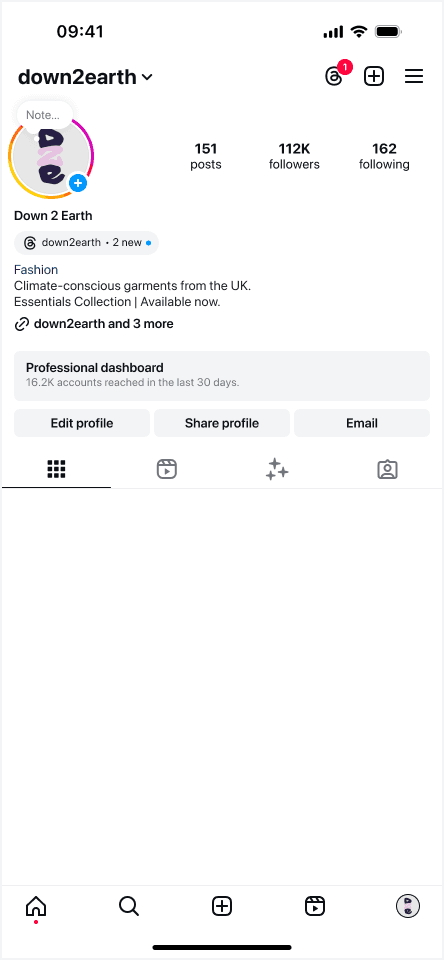
The Instagram profile reflects a highly curated aesthetic consistent with the brand’s overall visual identity. The focus on community-building is highlighted through the highlights section, establishing the brand as both stylish and conscious of modern digital culture. The stories image showcases the collection in a visually engaging format aiming at promoting immediate conversions by directly linking to the product page. It reinforces the cohesive branding found across other platforms while leveraging social media’s interactive nature. This is consistent to the competitors within the market and results in engagement with followers follow-through.
Across all design elements, the emphasis on sustainability is clear and intentional. From the product descriptions mentioning recycled textiles to the branding asset choices that reflect natural and organic shapes, everything points to an environmentally conscious brand identity.
The play on words for the 'Eco-ssential' campaign connects environmental elements with consumerist ideology. The 'eco' part connotes the brand's vision paired with the 'essential' garment that is needed within everyone's wardrobe. The campaign visuals are clean and modern, balancing between simplicity and the boldness of the main brand typeface. The choice of paired font from the brand identity used for the body text across the brand, enhances legibility while keeping the focus on the products on website and for marketing material.
Time Management
Using the Gantt chart created in the research proposal, I had mapped out the summer months to illustrate the projects timeline and time management. A vast amount of the project was planned to be design-oriented as that is what the Masters is focused on and is developing my skills for employment opportunities post-submission.
However, the primary and secondary took longer than expected. This was particularly because of the data analysis as I was unskilled in this area and found it difficult collating the responses and working out statistical values and analysing the 'why' behind the answers provided by survey participants. Using spreadsheet software was also unfamiliar and so I had to up-skill on this which extended the projects length.
In addition, the Figma prototype was the biggest part of the project which took a lot of allocation away from the social media and marketing design time. Therefore, these were not as polished as the website but still have space within this project as a deliverable. If anything was possible, more time would have been spent on creating a bigger campaign with real-life garment samples and a photoshoot with models to bring it to life on social media.
Deliverables
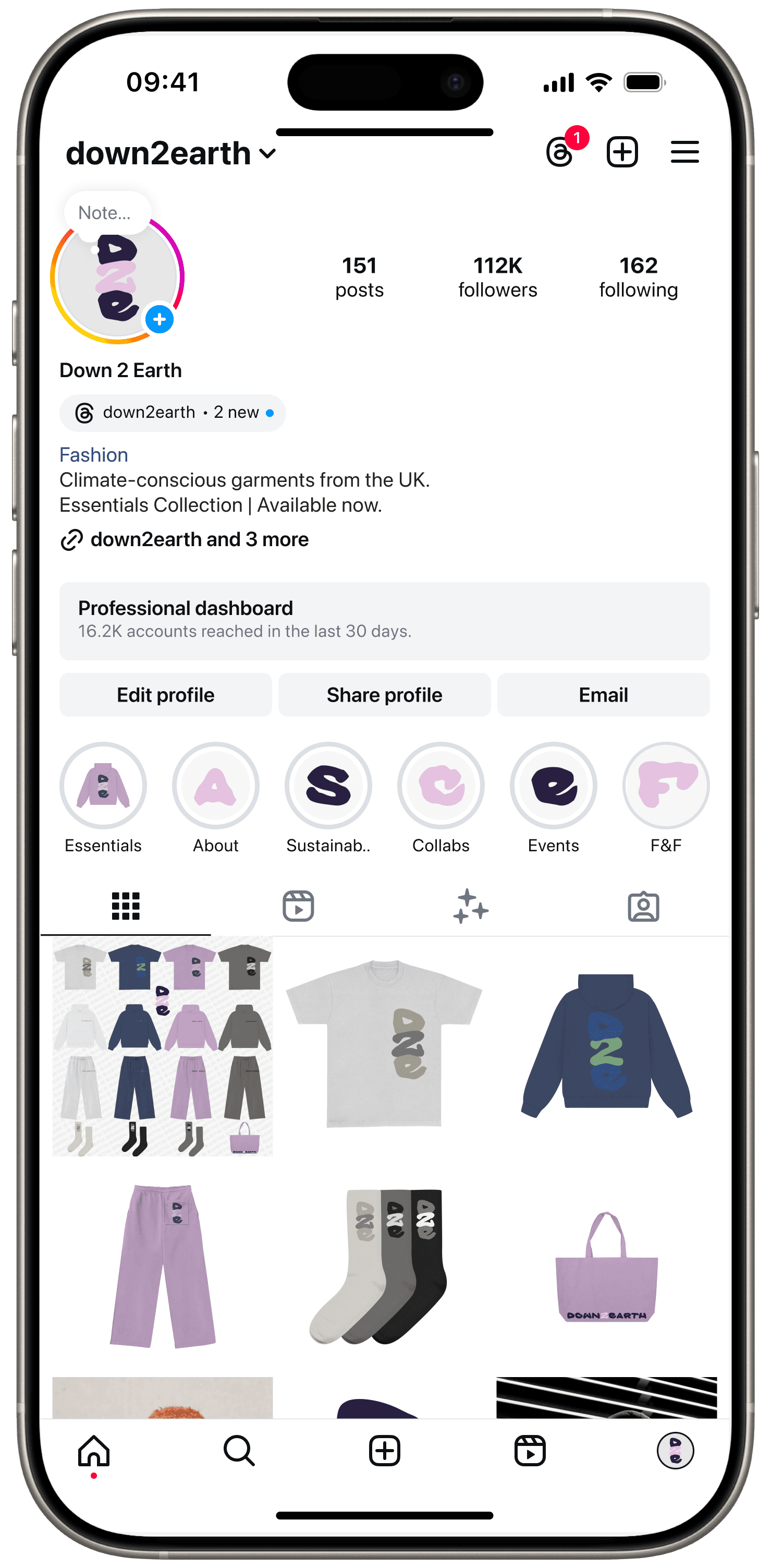

Conclusion
The design decisions throughout the project capture the intended audience-consumers interested in trends, yet pretty intentional in things they buy. Designs are completed in accordance with popular e-commerce practice, focusing on the brand's visual identity. Down 2 Earth effectively conveys its brand identity across all touch points, from the website and social media account to the marketing material. Based on significant primary and secondary research, the project ascertained that certain consumer preferences noted in the survey respondents - especially those from highly educated, higher-income groups - favoured sustainability. Design decisions throughout the project were led by an analysis of industry trends and competitor review, ensuring D2E's website and social media presence would be stellar among competitors.
While the project completed the majority of the set objectives, there are aspects where further research work could be explored in refining future design. The present research could also be deeper in understanding shopping psychology, particularly about consumer behaviour and the influence of fast fashion trends. Again, the strategy in social media marketing could have more time devoted to perfecting it, with an extended campaign of product testing and photoshoots that would give tangible concepts. These factors are crucial in a rapidly changing electronic commerce environment. Implementing these ideas into a variant website or even brand strategy would mean that the designs are truly at the forefront of ethical fashion moving into 2025. Finally, the innovative ideas and deliverables represented in this project offer an avenue for change in the fashion industry. Although it's just an idea, it can further press ethics and create a base for new brands to build from.
Bibliography
Ahmad, N., Salman, A. and Ashiq, R. (2015). The impact of social media on fashion industry: Empirical investigation from karachiites. ResearchGate. Available at: https://www.researchgate.net/publication/275714886_The_Impact_of_Social_Media_on_Fashion_Industry_Empirical_Investigation_from_Karachiites [Accessed 23 August 2024].
Anisah, T.N., Luthfiana, D.N., Kumar, V., Ernestivita, G., Harnaji, B. and Najmudin, M. (2024). Green threads: Unveiling sustainable fashion preferences among Indonesian gen Z consumers. Asian Management and Business Review, pp.376–393. Available at: https://doi.org/10.20885/ambr.vol4.iss2.art13 [Accessed 13 August 2024].
ApparelMagic (2023) The Role of Social Media in Today’s Fashion Business Landscape. ApparelMagic. Available at: https://apparelmagic.com/the-role-of-social-media-in-todays-fashion-business-landscape/ [Accessed 19 September 2024].
Azevedo, I.M., Alves, T. and Pinto, A.B. (2024). Consumer awareness and the ethical footprint of fast fashion with a focus on Shein. Global Fashion Studies. Available at: https://doi.org/10.3846/bm.2024.1318 [Accessed 17 July 2024].
Bergstrand, D. & Åradsson, F. (2024). The impact of transparency, environmental sustainability, and ethical practices in marketing: Shaping Swedish Gen Z’s attitudes towards fast fashion brands, Swedish Journal of Consumer Behaviour. Available at: http://lnu.diva-portal.org/smash/get/diva2:1897238/FULLTEXT01.pdf [Accessed 22 August 2024].
Bernovskis, A., Sceulovs, D. and Stibe, A. (2024) Society 5.0: Shaping the Future of e-commerce. Journal of Open Innovation Technology Market and Complexity. Available at: https://doi.org/10.1016/j.joitmc.2024.100391 [Accessed 21 August 2024].
Bläse, R., Filser, M., Krauys, S., Puumalainen, K., and Moog, P. (2023) Non-sustainable buying behavior: How the fear of missing out drives purchase intentions in the fast fashion industry. Business Strategy and the Environment, 33 (2), pp.626-614. Available at: https://doi.org/10.1002/bse.3509 [Accessed 19 August 2024].
Bommanavar, S.M. and Malipatil, S. (2024). New Culture Fashion: The Convergence of Slow Fashion, Sustainability and Fast Fashion. UGC Care Group I Journal, 85 (16), pp.133-142. Available at: https://www.researchgate.net/profile/Santosh-Bommanavar/publication/382367033_New_Culture_Fashion_The_Convergence_of_Slow_Fashion_Sustainability_and_Fast_Fashion/links/669a327102e9686cd10dcff4/New-Culture-Fashion-The-Convergence-of-Slow-Fashion-Sustainability-and-Fast-Fashion.pdf. [Accessed 10 August 2024].
Brewer, M.K. (2024) Slow Fashion in a Fast Fashion World: Promoting Sustainability and Responsibility. Laws, 8 (24). Available at: https://doi.org/10.3390/laws8040024 [Accessed 11 August 2024].
Broken Planet (2024) Home. Available at: https://www.brokenplanet.com [Accessed 8 June 2024].
Feshchenko, A. (2024) Information architecture of websites of selected companies from the clothing industry: a competitive analysis. Available at: https://ruj.uj.edu.pl/entities/publication/25d511f2-1b67-4c62-ad31-258757285120 [Accessed 20 September 2024].
Hur, E. and Cassidy, T. (2019) Perceptions and attitudes towards sustainable fashion design: challenges and opportunities for implementing sustainability in fashion. InternationalJournal of Fashion Design, Technology and Education, 12 (2), pp.208-217. Available at: https://doi.org/10.1080/17543266.2019.1572789 [Accessed 21 August 2024].
Jayakumari, M., Hayavadana, J., Srinivasulu, K., Murthy, E.K., Priyanka, S. and Vijayasarathy, M. (2024) Ethical Issues in Textile Industry. African Journal of Biomedical Research, 27 (1s), pp.2889-2895. Available at: https://doi.org/10.53555/AJBR.v27i1S.1927 [Accessed 19 August 2024].
Jin, Y. (2024) Clothing Waste in the Fashion Industry: History, Background and a Way Forward. Available at: https://www.actonscholars.org/wp-content/uploads/Clothing-Waste-in-the-Fashion-Industry.pdf [Accessed 16 September 2024].
Keenan, M. (2024) Fashion Ecommerce Trends + Stats 2024. ShopifyPlus. Available at: https://www.shopify.com/in/enterprise/blog/ecommerce-fashion-industry [Accessed 2 August 2024].
Khare, K. and Seshadri, S. (2024) Promoting Sustainable Clothing Care: Evaluating the Environmental Impact and Efficiency of Steaming and Laundry Practices. DIVA. Available at: https://www.diva-portal.org/smash/record.jsf?pid=diva2%3A1900504&dswid=-2401 [Accessed 9 August 2024].
Kim, K. H. and Kim, E.Y. (2020) Fashion marketing trends in social media and sustainability in fashion management. Journal of Business Research, 117 (0148-2963), pp.508-509. Available at: https://doi.org/10.1016/j.jbusres.2020.06.001https://doi.org/10.1016/j.jbusres.2020.06.001 [Accessed 11 July 2024].
Kothari, D.N., and Sohoni, S.N. (2024). Towards Sustainable Fashion: Managing Micro-trends and Reducing Overconsumption and Overproduction. In: Choudhary, A.S. and Singh, S. (eds.) Technological Innovation and Sustainability: Navigating the Future Through Fashion. SAAR Publications, 82-93.
La Rosa, A. And Johnson-Jorgensen, J. (2021). Influences on Consumer Engagement with Sustainability and the Purchase Intention of Apparel Products. Sustainability, 13 (19). Available at: https://doi.org/10.3390/su131910655 [Accessed 21 August 2024].
Madani, C, N. and Lapian, S.L.H.V.J. (2024) The Influence of Service Quality, Price and Lifestyle on Student Purchase Decisions of Shopee Users at Sam Ratulangi University. Journal EMBA, 12 (3), pp.1497-1510. Available at: https://doi.org/10.35794/emba.v12i03 [Accessed 30 August 2024].
McNeil, L. and Moore, R. (2015) Sustainable fashion consumption and the fast fashion conundrum: Fashionable consumers and attitudes to sustainability in clothing choice. International Journal of Consumer Studies, 39 (3), pp.212-222. Available at: https://doi.org/10.1111/ijcs.12169 [Accessed 18 July 2024].
Mileva, G. (2023) Top Fashion eCommerce Stats, Facts and Trends Every Retailer Should Be Aware Of. Influencer Marketing Hub. Available at: https://influencermarketinghub.com/fashion-ecommerce-stats/ [Accessed 16 June 2024].
Mohammed, S.A.Z.S. (2024) The impact of deconstructive architecture on the design of transformative clothing for women as part of the application of sustainable fashion. Journal of Heritage and Design. Available at: https://doi.org/10.21608/JSOS.2024.315087.1626. [Accessed 29 July 2024].
Nurgaliyeva, G. (2024) Unique Features and Capabilities of Storytelling in Social Networks. Eurasian Journal of Academic Research, 4 (6), pp.65-69. Available at: https://doi.org/10.5281/zenodo.12648847 [Accessed 19 July 2024].
Parvin, K.A, and Zilahy, G. (2022) Consumers’ Post-purchase Behaviour of Fashion Products. ResearchGate. Available at: https://www.researchgate.net/publication/384264735_Consumers%27_Post-purchase_Behaviour_of_Fashion_Products [Accessed 15 September 2024].
Priyadarshini, I. and Devi, U. (2024) From Fast Fashion to Sustainable Innovation: Managing the Social and Environmental Impact of Fashion Tech. International Journal of Engineering Technology and Management Sciences, 8 (2), pp.37-45. Available at: https://doi.org/10.46647/ijetms.2024.v08i02.005 [Accessed 15 August 2024].
Represent (2024) Home. Available at: https://representclo.com [Accessed 8 June 2024].
Sela, S, M., Saerang, D, P, E. and Rogi, M. H. (2024) The Influence of Scarcity Messages and Pay Later Payment Method on Impulse Buying Behaviour of Gen Z Shopee Users in Manado. Journal EMBA, 12 (3), pp.1455-1464. Available at: https://doi.org/10.35794/emba.v12i03 [Accessed 27 August 2024].
Soron, D. (2010) Sustainability, self-identity and the sociology of consumption. Sustainable Development, 18, pp.172–181. [Accessed 29 June 2024].
Sultana, S., Fakiha, T. and Sarker, B.C. (2024) Factors Affecting the Clothing Purchase Intention of Young Consumers through Online. Journal of Population and Development, 5 (1), pp.59-72. Available at: https://doi.org/10.3126/jpd.v5i1.67547 [Accessed 27 August 2024].
Surjit, R., Tarunvalavan, K.S., Sruthi, V. and Shanruthi, H. (2024) CSR Activities of Fast Fashion Brands: A Move Toward Sustainability. Corporate Social Responsibility in Textiles and Fashion, pp.159-176. [Accessed 1 September 2024].
The Business Research Company. (2024) Fashion E-Commerce Market Report. Available at: https://www.researchandmarkets.com/reports/5939666/fashion-e-commerce-market-report?srsltid=AfmBOoqoLWGLaQPmekOd-476lpbXTaNVQDnWLjnb9mh9Z0RAMHX-H1EQ [Accessed 22 July 2024].
Uphance. (n.d.) The Ultimate Guide to Social Media in Fashion: Everything You Need to Know. Uphance. Available at: https://www.uphance.com/insights/guide-to-social-media-in-fashion/ [Accessed 10 June 2024].
Widodo, A. (2024) Indonesia’s online shopping sector transformation: Analyzing the effects of online shopping app growth, e-commerce user adoption, Generation Y and Z, and shopping app advertising. Pakistan Journal of Life and Social Sciences (PJLSS), 22 (2). Available at: https://doi.org/10.57239/PJLSS-2024-22.2.00413 [Accessed 29 August 2024].




